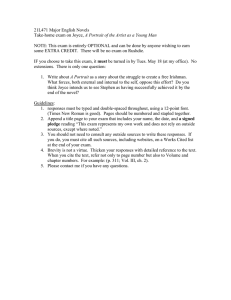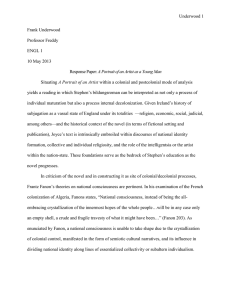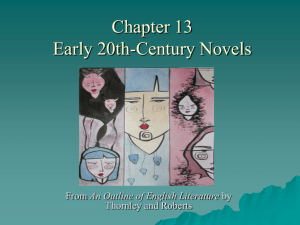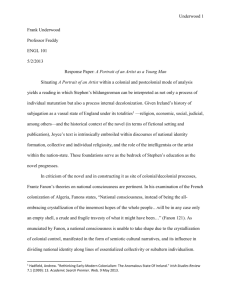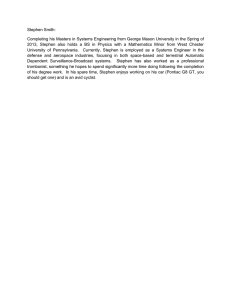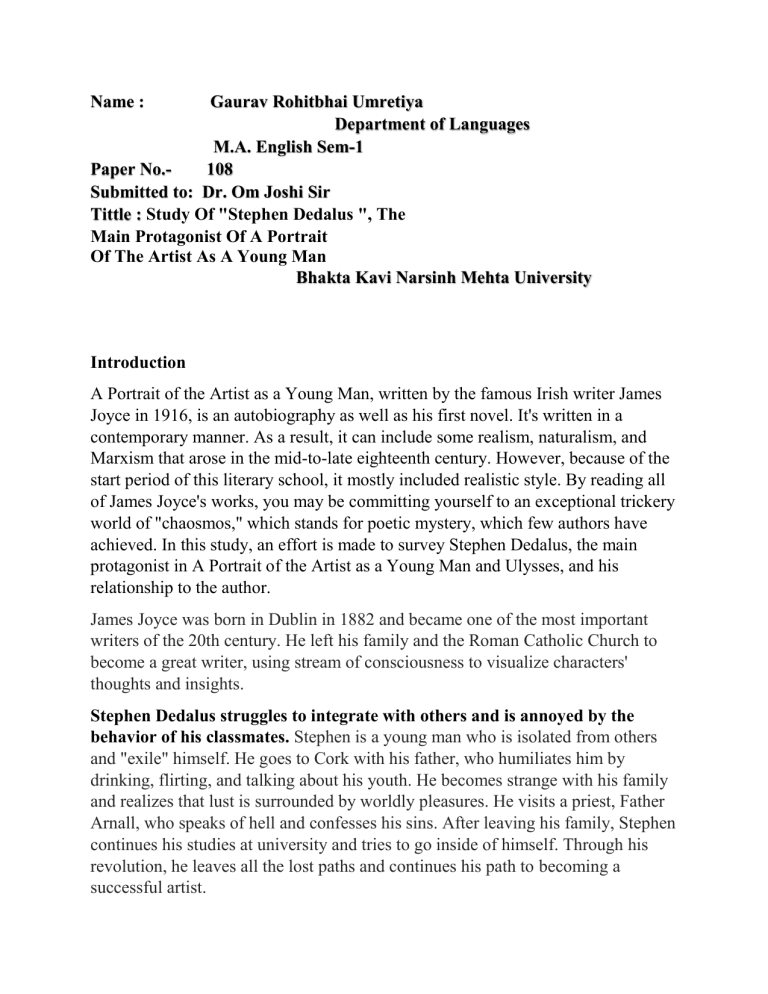
Name : Gaurav Rohitbhai Umretiya Department of Languages M.A. English Sem-1 Paper No.108 Submitted to: Dr. Om Joshi Sir Tittle : Study Of "Stephen Dedalus ", The Main Protagonist Of A Portrait Of The Artist As A Young Man Bhakta Kavi Narsinh Mehta University Introduction A Portrait of the Artist as a Young Man, written by the famous Irish writer James Joyce in 1916, is an autobiography as well as his first novel. It's written in a contemporary manner. As a result, it can include some realism, naturalism, and Marxism that arose in the mid-to-late eighteenth century. However, because of the start period of this literary school, it mostly included realistic style. By reading all of James Joyce's works, you may be committing yourself to an exceptional trickery world of "chaosmos," which stands for poetic mystery, which few authors have achieved. In this study, an effort is made to survey Stephen Dedalus, the main protagonist in A Portrait of the Artist as a Young Man and Ulysses, and his relationship to the author. James Joyce was born in Dublin in 1882 and became one of the most important writers of the 20th century. He left his family and the Roman Catholic Church to become a great writer, using stream of consciousness to visualize characters' thoughts and insights. Stephen Dedalus struggles to integrate with others and is annoyed by the behavior of his classmates. Stephen is a young man who is isolated from others and "exile" himself. He goes to Cork with his father, who humiliates him by drinking, flirting, and talking about his youth. He becomes strange with his family and realizes that lust is surrounded by worldly pleasures. He visits a priest, Father Arnall, who speaks of hell and confesses his sins. After leaving his family, Stephen continues his studies at university and tries to go inside of himself. Through his revolution, he leaves all the lost paths and continues his path to becoming a successful artist. James Joyce's A Portrait of the Artist as a Young Man and Ulysses explores the insufficiency of self-awareness and freedom in Stephen Dedalus' life, leading to loss, failure, and destruction. Stephen chooses to be artist because he wants to be free from all the rules and regulations, and escapes from this material world by using wax wings. He experiences exile, silence, and cunning, and the story is a symbolic, alligorical autobiography of the author. James Joyce's "A Portrait of the Artist as a Young Man" is a seminal modernist novel that explores the inner workings of the mind of its protagonist, Stephen Dedalus, as he struggles to establish his identity and artistic vision. In this critical study, we will examine the novel in the light of modernist theory, focusing on its narrative techniques, themes, and stylistic innovations. One of the central tenets of modernist literature is the rejection of traditional narrative techniques in favor of more experimental forms of storytelling. Joyce employs a range of innovative techniques in "A Portrait of the Artist as a Young Man," including free indirect discourse, stream-of-consciousness narration, and non-linear narrative structure. These techniques serve to convey Stephen's subjective experiences and inner thoughts, blurring the boundaries between reality and perception. The novel also explores the theme of individuality and the search for a personal identity. Stephen's struggle to define himself as an artist is emblematic of the modernist rejection of traditional values and conventions. He seeks to break free from the constraints of religion, nationalism, and societal norms, and to find his own voice and vision. This theme is reflected in Joyce's use of symbolism, such as the recurring motif of flight, which symbolizes Stephen's desire for freedom and transcendence. Another hallmark of modernist literature is the use of fragmentation and dislocation to reflect the chaos and uncertainty of the modern world. Joyce employs this technique in the novel by juxtaposing Stephen's childhood memories and his present experiences, and by including a range of different narrative perspectives and styles. The result is a fragmented and multi-layered narrative that reflects the complexity of Stephen's inner world. Finally, "A Portrait of the Artist as a Young Man" is a highly stylistic novel that challenges conventional notions of language and narrative. Joyce employs a range of literary devices, such as puns, allusions, and wordplay, to create a dense and intricate text that rewards close reading and analysis. His use of language is often musical and poetic, with recurring rhythms and patterns that contribute to the overall effect of the novel. In conclusion, "A Portrait of the Artist as a Young Man" is a seminal modernist novel that employs a range of innovative narrative techniques and explores themes of individuality, fragmentation, and linguistic experimentation. It remains a landmark work of literature that continues to inspire and challenge readers to this day.
